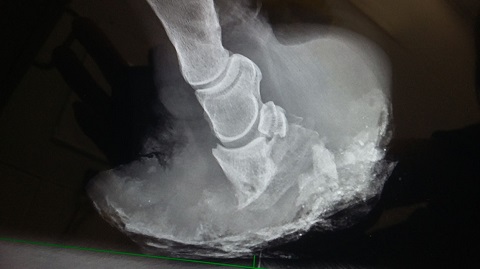24 hour contact: 01707 666297
Laminitis
What is Laminitis?
Laminitis is a common, extremely painful and frequently recurrent condition in horses, ponies and donkeys.
It has significant welfare implications for owners. This condition affects the tissues (laminae) bonding the hoof wall to pedal bone in the hoof. This can result in the pedal bone sinking or rotating within the hoof under the weight of the horse. In extreme cases this can result in penetration the sole of the foot by the pedal bone. More than 7% of equine deaths are linked to the laminitis, with many animals having to be euthanased.

What are the causes of Equine Laminitis?
Laminitis can arise in three general situations:
- Diseases associated with inflammation
e.g. certain types of colic, diarrhoea, retained placenta, severe pneumonia
The precise sequence of events leading to laminitis is still unclear. In diseases associated with inflammation, the exact identity of the laminitis trigger remains elusive, but there is activation of inflammation throughout the body which results in turn in lamellar inflammation. The end result is failure of the adhesion between the laminae and laminitis
- Endocrine (hormone) disease
e.g. Equine Cushing’s disease (pituitary pars intermedia dysfunction; PPID) and equine metabolic syndrome (EMS)
The hormone insulin appears to be important in laminitis associated with endocrine disorders, but again the exact sequence of events remains unclear.
- Mechanical overload - supporting limb laminitis (SLL)
e.g. associated with a fracture or infected joint in the other leg so that the leg which is bearing all of the weight is at risk of laminitis.
In mechanical overload laminitis, it is thought that there is inadequate blood supply to the lamellar tissue associated with excessive and continuous weight-bearing.
Can a horse die from laminitis?
The horse is unlikely to die from laminitis, but an owner may take the decision to euthanase their animal if the pedal bone penetrate the sole so that the outlook is very poor or if their animal does not respond to appropriate treatment over a prolonged period.
Can a farrier cause laminitis?
This is not been documented. However a lack of farriery attention so that the feet become overgrown can result in abnormal stresses on the feet and hence laminitis.
What are the clinical signs of equine laminitis?
- Lameness* affecting most commonly at least two limbs. * Some horses get very mild laminitis that is not severe enough to cause any visible lameness but does result in divergent hoof growth rings.
- The horse leans back onto its heels to take the weight off the painful toe area
- The lameness is worse when the horse walks on hard ground or turns
- Shifting weight between feet when resting
- Increased digital pulses
- Pain with use of hoof testers at the point of frog on the foot
What should horse owners do if they suspect their horse has laminitis?
After calling your vet, bring your horse in from the field slowly and box rest them. You should make sure there is a deep bed that comes all the way up to the door, provide plenty of fresh water and feed your horse a diet based on poor quality hay. If necessary, the hay should be soaked to remove as much of the carbohydrate as possible.
How is a diagnosis for equine laminitis made?
- A laminitis diagnosis is usually based on the clinical signs being displayed
- X-rays may be taken if there is concern that the pedal bone has sunk or rotated, or if the animal is not improving despite appropriate therapy
- Blood tests may be performed in cases where an underlying endocrine disease is suspected.
What is the treatment for equine laminitis?
Laminitis is a medical emergency and horses should be seen by a vet so that they can receive treatment as soon as possible.
Various medicines can be given to control the pain including non-steroidal anti-inflammatory drugs (NSAIDs) such as phenylbutazone ('bute') or flunixin and opiates like morphine and pethidine. Acepromazine has been traditionally used to increase the blood supply to the feet as it was thought that all laminitis was a consequence of decreased hoof perfusion. The drug's beneficial effect is probably more related to its sedative properties resulting in the horse standing still or even lying down taking the weight off their feet. In cases of laminitis associated with inflammation, the short term (3 days) use of ice to cool the feet may be beneficial.
Foot support is a vital part of the treatment to help to limit movement of the pedal bone and to reduce the pain experienced by the horse.
The can be achieved in a variety of ways including providing a deep bed which extends all the way to the door, frogs supports attached to the feet such as Lilypads or TLC frog supports, or frog and sole combined supports such as dental impression material or Styrofoam pads.
Box rest along with dietary changes are important factors. Rather than grass, horses should have poor quality hay and no or minimal concentrates. Roughage rich foodstuffs like unmollassed sugar beet and chaff can form part of a revised diet.
If the laminitis is the result of an underlying condition, such as an endocrine disorder, the disease should be treated accordingly e.g. pergolide (Prascend) for PPID.
What do you feed a horse that has laminitis?
The diet should consist of poor quality hay fed at 1.5% of the horse’s actual body weight. If necessary, the hay should be soaked to remove as much of the carbohydrate as possible. Hay is preferable to haylage as haylage is more palatable so the animal will eat more and horses seem to produce more of the hormone insulin in response to haylage compared to hay. If necessary, fibre-based products that contain chaff or unmollassed sugar beet can be fed instead of some of the hay ration. If extra energy is required once the laminitis has resolved, then oil can be added to the diet.
What do you NOT feed to a horse that has laminitis?
Concentrates based on cereals should ideally not be fed as they are rich in carbohydrate.
Should you walk a horse with laminitis?
No. Whilst the horse has painful feet, they should be box rested.
Can a horse with laminitis go barefoot?
Yes if the vet and farrier feel that this is appropriate in an individual animal.
How long does it take for a horse to recover from laminitis?
It takes weeks to months for a horse to recover from laminitis. In one research study, 72% of animals were sound at the trot after 8 weeks and 60% were back in work.
Can a horse with laminitis be cured?
Once an animal has had laminitis, they will be at an increased risk of getting it again. The current episode can be cured, but it is likely that laminitis will occur again at some point in the future. Management changes should be put in place to minimise the risk of a repeat episode.
Equine laminitis - preventative measures
Prevention measures for laminitis associated with inflammation or sepis:
This can be prevented by prompt treatment of the underlying disease and use of ice to cool the feet in horses at risk of inflammation-associated laminitis prior to its occurrence.
Prevention measures for endocrine disorder-associated laminitis
This can be prevented by appropriate treatment of the underlying endocrine disorder and by reducing consumption of non-structural carbohydrates found in the pasture.
Prevention of mechanical overload laminitis
This can be prevented by using frog or frog and sole supports in high risk animals prior to its occurrence.
Key points about laminitis in horses
- Laminitis is extremely painful and debilitating for horses
- There is a failure of the tissues bonding the hoof wall to the pedal bone in the hoof. This can result in the bone rotating or sinking within the hoof.
- There are a number of underlying conditions that can lead to laminitis
- Horses with suspected laminitis need to be assessed by an equine vet and treated as quickly as possible
- Various medicines may be used for pain control and diet can be altered to reduce factors likely to cause or contribute to the condition

